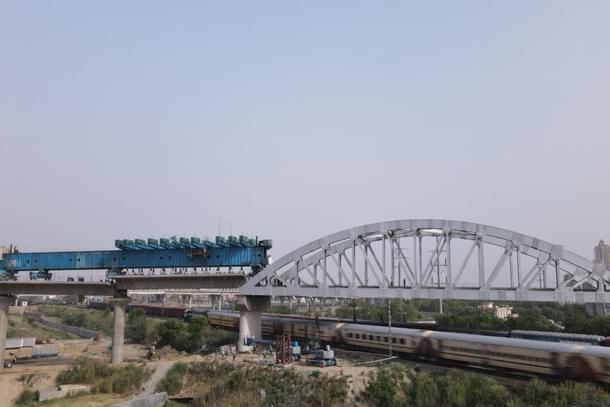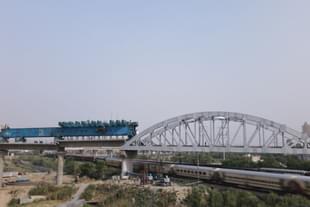Infrastructure
Why Is RRTS The Most Important Urban Infrastructure Project Of The 2020s?
Tushar Gupta
Feb 16, 2023, 12:59 PM | Updated 01:02 PM IST
Save & read from anywhere!
Bookmark stories for easy access on any device or the Swarajya app.


The last two decades were about transforming our key metropolitan areas and some state capitals into pockets of economic growth.
Going forward, the next two decades would be about bettering the infrastructure in these cities.
Urban migration will continue to happen at a steady pace, but in the years to come, more than ever before, people will be striving for better urban spaces, transportation options, green belts, and so forth.
In this context, the significance of the RRTS must be perceived.
The Regional Rapid Transit System (RRTS), led by the National Capital Region Transportation Corporation (NCRTC), is a giant leap forward from the metro networks, citizens in the urban areas are growing accustomed to.
To travel 100 kilometre, the average time taken would be 60 minutes, with the operational speed to be between 160-180 kilometre per hour (kmph), thus at least three times faster than the metro.
In RRTS’ first phase, three corridors have been envisioned; one each to Rajasthan, Uttar Pradesh, and Haryana.
If the economic value created by the Delhi Metro, in the last two decades, is assumed to be ‘x’ units, the potential economic value added by the three corridors of the RRTS could well be assumed to be at least ‘100x’ in the next two decades.
Purely from an economic point of view, the RRTS could be a gamechanger for the National Capital Region (NCR). India’s ten trillion economy dream will pass through eight-ten regions, like Pune, Bengaluru, Mumbai, Hyderabad, Chennai, but the RRTS puts NCR’s dream of becoming a trillion-dollar economy into the hyperdrive mode.
There are enough reasons to be bullish about the growth prospects of NCR as RRTS corridors become operational. The first 17 kilometer stretch is all set for inauguration in March 2023, on the Delhi-Meerut stretch.
To begin with, RRTS will change the way NCR is perceived as a region. As of today, Delhi, Ghaziabad, Noida, Gurugram, Faridabad, and scattered satellite towns and villages make up for the majority of accessible NCR via metro or car. With RRTS, the access will only grow. Think of a circle whose diameter has been increased ten-fold.
RRTS will do what the Delhi Metro has been doing for the last twenty years. Opening up opportunities for the people in the region, and enabling them to travel the most extreme distances that would be unviable via road for a routine.
Thus, someone can live in Panipat, around 80 km from the Delhi-Karnal bypass, or Meerut, around 75 km away from one eastern borders of Delhi, or Alwar, around 150-odd km from the Delhi airport, and yet, choose to work in the NCR region each day.
This opening up of access will have multiple consequences. For starters, it will reduce the number of cars on the roads.
For instance, there are plenty of professionals and entrepreneurs who use the Delhi-Meerut expressway or the Delhi-Panipat stretch (passing through Singhu) every day.
Two, it will ease the migration stress on Delhi which is already overburdened and plagued with several facets of pollution, from dust to automobiles, and also faces acute water shortage in summer months.
Further, the development of RRTS, across the next twenty years, would be critical in popping the real estate bubble that prevails within the NCR region (more about it here).
The ease of access and other issues plaguing the cities of Delhi, Gurugram, and Noida would inspire people to explore the suburbs, especially the areas around Sonipat (Delhi-Panipat), Manesar (Delhi-Alwar), and beyond Ghaziabad (Delhi-Meerut).
The security and civic development of these suburbs would have to go in tandem with the growth of the RRTS.
Another avenue for the governments to explore is the creation of Special Economic Zones (SEZs) around the three corridors of the RRTS.
Quite like the Greater Noida Metro line passes through the hotspots for the region’s services sector, the state governments of Rajasthan, Haryana, and Uttar Pradesh can allocate spaces for several industries like manufacturing, education, agriculture, logistics, and so forth.
The access is already there and the proximity to NCR and the upcoming Jewar International Airport is an added incentive.
The development on the routes should not be restricted to SEZs alone. The state governments must encourage several smaller economic pockets as well. For instance, on the Delhi-Panipat stretch, the Murthal region, famous for its food and host to thousands of residents from NCR each day, must be further developed.
RRTS would enable a demand for all the regions on the respective corridors. The onus lies with the government to aid the creation of supply. How about tax breaks for the first five years for companies investing in lands around the stretch?
The Delhi Metro started operations in 2002, and back then, not many could have imagined that twenty years later, it would enable more than five million trips each day (approximately 10 per cent of Delhi’s population) RRTS, with its three corridors, and another five in the second phase, would have the potential to move at least 30 million people from the word go.
However, there are two aspects the Centre and the participating state governments must be mindful of. One, revenue generation, and two, delay in project funding, approval, and construction.
Earlier this month, the Union Minister for Housing and Urban Affairs told the Rajya Sabha that the Delhi government had refused to fund the construction of the other two corridors (Delhi-Alwar, Delhi-Panipat).
Consequently, this has resulted in a delay for the approval. In August 2022, the Lt. Governor VK Saxena had also written to Delhi Chief Minister, citing concerns over the delay in approving critical infrastructure projects. In the larger interest of NCR, the political intricacies must be urgently addressed.
In another five years, when the early successes of the RRTS in NCR are visible, it would be ideal for the Centre and other state governments, especially in the regions around Bengaluru, Mumbai, Ahmedabad, Chennai, Hyderabad, and Pune to explore possibilities of similar corridors.
RRTS, in the larger scheme of things, is the most important infrastructure projects of the 2020s, and therefore, its application and implementation and the lessons drawn from it would be critical to the economic development of the region.
Tushar is a senior-sub-editor at Swarajya. He tweets at @Tushar15_




